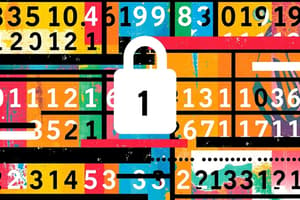Podcast
Questions and Answers
What is one of the key requirements for the Advanced Encryption Standard (AES) compared to Triple-DES?
What is one of the key requirements for the Advanced Encryption Standard (AES) compared to Triple-DES?
- Must be less secure
- Must support key sizes of 64 bits
- Must use asymmetric encryption
- Must have a block length of 128 bits (correct)
Which algorithm was selected as the proposed AES algorithm?
Which algorithm was selected as the proposed AES algorithm?
- Twofish
- Rijndael (correct)
- RC6
- Serpent
What aspect of AES is emphasized in the evaluation criteria for its selection?
What aspect of AES is emphasized in the evaluation criteria for its selection?
- Compatibility with all existing encryption algorithms
- General security and ease of implementation (correct)
- Simplicity of implementation in real-world applications
- Cost-effectiveness in production
Which key sizes are supported by the AES standard?
Which key sizes are supported by the AES standard?
What was the active life expectation for the AES as mentioned in the requirements?
What was the active life expectation for the AES as mentioned in the requirements?
What is the main purpose of confusion in encryption?
What is the main purpose of confusion in encryption?
Why was DES considered insecure by July 1998?
Why was DES considered insecure by July 1998?
How does the effective key length of Triple DES compare to that of DES?
How does the effective key length of Triple DES compare to that of DES?
What was a significant limitation of DES identified in studies after its introduction?
What was a significant limitation of DES identified in studies after its introduction?
Which organization was responsible for the development of the Data Encryption Standard (DES)?
Which organization was responsible for the development of the Data Encryption Standard (DES)?
What is the primary purpose of symmetric key encryption in the communication between Alice and Bob?
What is the primary purpose of symmetric key encryption in the communication between Alice and Bob?
In symmetric key encryption, what does the key represent?
In symmetric key encryption, what does the key represent?
What would happen if Oscar learns the key K used by Alice and Bob?
What would happen if Oscar learns the key K used by Alice and Bob?
What is the significance of the equalities $d_K(y) = d_K(e_K(x)) = x$ in symmetric key encryption?
What is the significance of the equalities $d_K(y) = d_K(e_K(x)) = x$ in symmetric key encryption?
Which of the following best describes the term 'key space' in the context of symmetric key encryption?
Which of the following best describes the term 'key space' in the context of symmetric key encryption?
What happens if Alice and Bob do not use a secure channel to transmit the key?
What happens if Alice and Bob do not use a secure channel to transmit the key?
Why is the storage of the key K important in symmetric key encryption?
Why is the storage of the key K important in symmetric key encryption?
What type of encryption is symmetric key encryption also known as?
What type of encryption is symmetric key encryption also known as?
What is the primary structure that most symmetric block ciphers are based on?
What is the primary structure that most symmetric block ciphers are based on?
What design element of the Feistel cipher can improve security but may slow down the cipher?
What design element of the Feistel cipher can improve security but may slow down the cipher?
Which of these statements about Blowfish is correct?
Which of these statements about Blowfish is correct?
How does the decryption process in a Feistel cipher compare to the encryption process?
How does the decryption process in a Feistel cipher compare to the encryption process?
What distinguishes Twofish from other block ciphers?
What distinguishes Twofish from other block ciphers?
Which of the following is a notable Feistel cipher?
Which of the following is a notable Feistel cipher?
The IDEA algorithm primarily differs from DES in that it does not use what?
The IDEA algorithm primarily differs from DES in that it does not use what?
Which of the following features is unique to the Skipjack algorithm?
Which of the following features is unique to the Skipjack algorithm?
Which statement about Twofish and AES is accurate?
Which statement about Twofish and AES is accurate?
What method does the IDEA algorithm use instead of exclusive-or for processing?
What method does the IDEA algorithm use instead of exclusive-or for processing?
What is a characteristic of the Blowfish algorithm compared to DES?
What is a characteristic of the Blowfish algorithm compared to DES?
In what context is the IDEA algorithm commonly used?
In what context is the IDEA algorithm commonly used?
What aspect of the Feistel cipher design enhances security through unpredictable output changes?
What aspect of the Feistel cipher design enhances security through unpredictable output changes?
What is the purpose of the key schedule in the S-P network?
What is the purpose of the key schedule in the S-P network?
Which operation is used to create the round keys in AES key expansion?
Which operation is used to create the round keys in AES key expansion?
In which of the following steps does AES encryption NOT apply an inverse operation?
In which of the following steps does AES encryption NOT apply an inverse operation?
What characterizes the byte substitution in AES?
What characterizes the byte substitution in AES?
What is the main purpose of the Mix Columns step in AES?
What is the main purpose of the Mix Columns step in AES?
How does AES decryption differ fundamentally from AES encryption?
How does AES decryption differ fundamentally from AES encryption?
What is a key feature of the AES key expansion process?
What is a key feature of the AES key expansion process?
What is the result of swapping the byte substitution and shift rows operations in AES?
What is the result of swapping the byte substitution and shift rows operations in AES?
What is the role of round constants in AES key expansion?
What is the role of round constants in AES key expansion?
What type of cipher structure does the Feistel cipher implement?
What type of cipher structure does the Feistel cipher implement?
Flashcards
Symmetric Key Encryption
Symmetric Key Encryption
A method of encrypting and decrypting data using the same secret key for both processes.
Key
Key
A secret value used in encryption and decryption algorithms.
Encryption
Encryption
The process of converting readable data (plaintext) into an unreadable format (ciphertext).
Decryption
Decryption
Signup and view all the flashcards
Plaintext
Plaintext
Signup and view all the flashcards
Ciphertext
Ciphertext
Signup and view all the flashcards
Key Space
Key Space
Signup and view all the flashcards
Secure Channel
Secure Channel
Signup and view all the flashcards
Symmetric Cipher
Symmetric Cipher
Signup and view all the flashcards
Cipher Confusion
Cipher Confusion
Signup and view all the flashcards
Cipher Diffusion
Cipher Diffusion
Signup and view all the flashcards
One-Time Pad
One-Time Pad
Signup and view all the flashcards
Data Encryption Standard (DES)
Data Encryption Standard (DES)
Signup and view all the flashcards
DES Key Length
DES Key Length
Signup and view all the flashcards
Triple DES
Triple DES
Signup and view all the flashcards
Brute-Force Attack
Brute-Force Attack
Signup and view all the flashcards
Block Cipher
Block Cipher
Signup and view all the flashcards
AES
AES
Signup and view all the flashcards
NIST
NIST
Signup and view all the flashcards
Rijndael
Rijndael
Signup and view all the flashcards
128/192/256-bit keys
128/192/256-bit keys
Signup and view all the flashcards
Block Cipher
Block Cipher
Signup and view all the flashcards
Evaluation Criteria
Evaluation Criteria
Signup and view all the flashcards
Symmetric Key Cipher
Symmetric Key Cipher
Signup and view all the flashcards
AES Round
AES Round
Signup and view all the flashcards
Byte Substitution
Byte Substitution
Signup and view all the flashcards
Shift Rows
Shift Rows
Signup and view all the flashcards
Mix Columns
Mix Columns
Signup and view all the flashcards
Add Round Key
Add Round Key
Signup and view all the flashcards
AES Key Expansion
AES Key Expansion
Signup and view all the flashcards
Key Schedule
Key Schedule
Signup and view all the flashcards
Round Key
Round Key
Signup and view all the flashcards
S-box
S-box
Signup and view all the flashcards
Feistel Cipher
Feistel Cipher
Signup and view all the flashcards
Blowfish
Blowfish
Signup and view all the flashcards
Blowfish Key Length
Blowfish Key Length
Signup and view all the flashcards
Blowfish Block Size
Blowfish Block Size
Signup and view all the flashcards
TwoFish
TwoFish
Signup and view all the flashcards
Twofish Key Length
Twofish Key Length
Signup and view all the flashcards
Skipjack
Skipjack
Signup and view all the flashcards
Skipjack Key Escrow
Skipjack Key Escrow
Signup and view all the flashcards
Feistel Cipher Structure
Feistel Cipher Structure
Signup and view all the flashcards
Block Size (Cipher)
Block Size (Cipher)
Signup and view all the flashcards
Key Size (Cipher)
Key Size (Cipher)
Signup and view all the flashcards
Subkey Generation
Subkey Generation
Signup and view all the flashcards
Round Function
Round Function
Signup and view all the flashcards
Decryption (Feistel)
Decryption (Feistel)
Signup and view all the flashcards
Diffusion (Cipher)
Diffusion (Cipher)
Signup and view all the flashcards
Confusion (Cipher)
Confusion (Cipher)
Signup and view all the flashcards
IDEA Algorithm
IDEA Algorithm
Signup and view all the flashcards
Pretty Good Privacy (PGP)
Pretty Good Privacy (PGP)
Signup and view all the flashcards
Study Notes
Symmetric Key Encryption
- Symmetric key encryption uses the same key for encryption and decryption
- The problem is transmitting the secret key securely.
- This type of cryptography uses a shared secret key known to both the sender and receiver.
- A malicious third party (eg Oscar) should not be able to understand the communication.
Outline
- Introduction to Symmetric Key Encryption
- Common Symmetric Key Algorithms
- Block Cipher Operation Modes
Alternative Names
- Private Key, Single Key, or Secret Key Cryptography
Problem Statement
- Alice and Bob want to communicate via an insecure channel (e.g., internet, WLAN).
- A malicious third party (Oscar) wants access to the channel but should not be able to understand the communication
Solution: Symmetric Cipher
- Encryption with a symmetric cipher
- Oscar only obtains ciphertext y (random bits).
- Alice encrypts message x with key K
- Key Generator generates secret key K
- Secure Channel transmits encrypted message y
- Bob decrypts message with key K
- x is the plaintext, y is the ciphertext, K is the key.
- The set of all keys {K1, K2, ..., Kn} is called the key space
Encryption and Decryption Equations
- y = ek(x) (Encryption)
- x = dk(y) (Decryption)
- ek and dk are inverse operations if the same key K is used.
Confusion and Diffusion
- A cipher needs to completely obscure statistical properties of the original message.
- A one-time pad does this.
- More practically Shannon suggested combining S&P elements.
- Diffusion dissipates the statistical structure of the plaintext over the bulk of the cipher text.
- Confusion is making the relationship between ciphertext and key as complex as possible.
Data Encryption Standard (DES)
- DES was the first modern standard symmetric key encryption scheme.
- Originally developed by IBM.
- DES became the most widely used block cipher in the world
- DES encrypts 64-bit data using a 56-bit key
- DES was proved insecure in 1998 due to brute-force attacks and short keys.
Strength of DES
- 56-bit keys have 256 values, making brute-force attacks hard.
- In 1997, discovering the key was possible in a few months using an executive search.
- In 1998, hardware attacks by Electronic Frontier Foundation with $220,000 cost could break DES in a few days.
- In 1999, DES was broken in 22 hours.
Triple DES
- Made part of DES in 1999
- Uses 3 keys and 3 DES executions.
- 3DES has an effective key length of 168 bits (3*56).
- Double DES also exists, but its effective key length is weaker.
National Institute of Standards and Technology (NIST)
- NIST is a US Federal Agency within the Department of Commerce.
- Its mission is to promote innovation and industrial competitiveness by advancing measurement science, standards, and technology.
- In 1997, NIST issued a call for a new Advanced Encryption Standard (AES).
Advanced Encryption Standard (AES)
- In 1997, US NIST issued a call for a new AES with requirements.
- Security strength better than 3DES
- Significantly more efficient
- Increased block length (128 bits)
- Support key sizes of 128, 192, and 256 bits
Advanced Encryption Standard (AES) - Rijndael
- Designed by Daemen and Rijmen in Belgium.
- Has 128/192/256-bit keys, 128-bit data.
- An iterative rather than Feistel cipher.
- Processes data as a block of 4 columns of 4 bytes in every round.
AES Cipher – Rijndael
- Data block of 4 columns of 4 bytes.
- Key is expanded to an array of words
- Each round is built from four basic steps:
- Byte Substitution
- Shift Rows.
- Mix Columns
- Add Round Key
Byte Substitution (1 S-Box)
- A simple substitution of each byte
- Uses a table of 16x16 bytes for permutation of all 8-bit values
- Each byte of state is replaced with one indexed by row (left 4 bits) and column (right 4 bits)
Shift Rows
- Circular byte shift
- 1st row is unchanged.
- 2nd row does 1 byte circular shift to left.
- 3rd row does 2 byte circular shift to left.
- 4th row does 3 byte circular shift to left.
Mix Columns
- Each byte is replaced by a value dependent on all 4 bytes in the column.
- Matrix multiplication.
- Can be expressed as 4 equations to derive the new byte.
Add Round Key
- XOR state with 128 bits of the round key.
- Again processed by column.. (bit operations).
- Inverse for decryption is identical (using reversed keys).
- Designed to be simple.
AES Key Expansion
- Takes 128-bit (16-byte) key and expands into an array of 44/52/60 32-bit words.
- Starts by copying the key into the first 4 words.
- Loop creates words depending on values in previous 4 places.
- 1st word in 4 has rotation, S-box, and XOR round constant on previous, before XORing 4th back
Key Expansion Rationale
- Designed to resist known attacks.
- Design criteria including:
- Knowing part key insufficient.
- Invertible transformation.
- Fast on wide range of CPUs.
- Use round constants to break symmetry.
- Diffuse key bits into round keys.
- Enough non-linearity to hinder analysis.
- Simplicity of description.
AES Decryption
- AES decryption is not identical to encryption, but an equivalent inverse cipher with steps as for encryption is defined.
- Decryption uses inverses of each step and a different (inverse) key schedule.
Feistel Cipher
- Horst Feistel developed Feistel cipher at IBM.
- Implements Shannon's substitution-permutation network concept.
- Most symmetric block ciphers are based on a Feistel cipher structure.
How Feistel Cipher Works
- Partitions input block into two halves.
- Processes through multiple rounds
- In every round:
- Performs a substitution on the left data half based on a round function of right half & subkey.
- Then has permutation-swapping halves.
Feistel Cipher Design Elements
- Block size: Increasing size improves but slows down the cipher.
- Key size: Increasing size improves security but may slow down exhaustive key-searching.
- Subkey generation: Greater complexity to make analysis harder but may slow down the cipher.
- Round function: Greater complexity to make analysis harder but slower cipher.
Feistel Cipher Decryption
- The Feistel structure ensures the decryption process mirrors the encryption process.
- The round keys are in reverse order (when compared to the encryption round).
Feistel Cipher Security
- Diffusion & confusion provides security through small changes in input resulting in significant changes to the output.
- Structure is the foundation for many well-known ciphers (like DES).
IDEA Algorithm
- International Data Encryption Algorithm (IDEA)
- Developed in Switzerland in 1991.
- Uses a 128-bit key, 64-bit block size, 8 rounds.
- Different from DES, it doesn't use S-boxes, but binary addition instead of exclusive-or.
- Used in Pretty Good Privacy (PGP).
Pretty Good Privacy (PGP)
- PGP is a software library providing encryption and decryption for data communication.
- Includes open-source software for key management, allowing creation, modification, and revocation of digital certifications.
- Validates the authenticity of digital certifications.
- Created by Phil Zimmermann in 1991, stable release in 2018.
Blowfish
- Proposed by Bruce Schneier in 1993.
- A popular alternative to DES.
- Variable-length keys (128 bits to 448 bits) and variable number of rounds (up to 16).
- Uses a 64-bit block size
- Used in many commercial software packages
- Initially proprietary, now free.
Twofish
- Developed by Bruce Schneier
- One of the AES finalists.
- A block cipher operating on 128-bit blocks of data capable of using cryptographic keys up to 256 bits in length.
- Uses pre-whitening and post-whitening techniques protecting against known plaintext attacks.
Skipjack Algorithm
- Approved for use by the US government.
- Part of the Escrowed Encryption Standard (EES).
- Works with 64-bit blocks of text and uses an 80-bit key
- Skipjack has an additional "twist"- it supports escrow of encryption keys.
- Two government agencies, National Institute of Standards and Technology (NIST) and the Department of the Treasury hold portions for reconstructing Skipjack key.
Studying That Suits You
Use AI to generate personalized quizzes and flashcards to suit your learning preferences.




